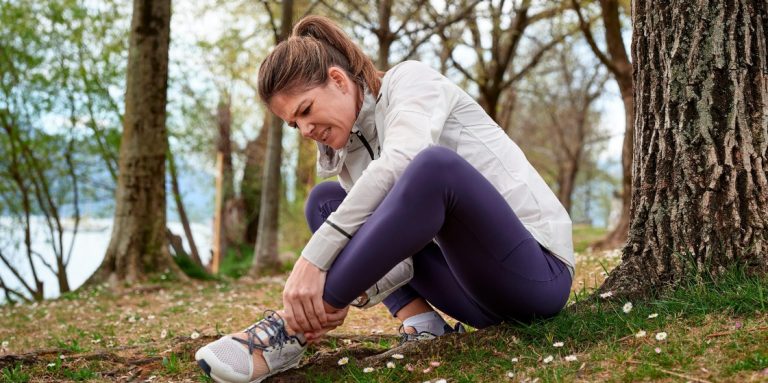
How to avoid running injuries
Running is good for you – as long as you don’t overdo it. Otherwise you run the risk of pain and injury. Here’s how you can avoid this.
If, after running, your knee hurts, muscle stiffness won’t go away or you have cramp, these are often signs that you have overdone it. These signs are something you should always take seriously.
“Pain is a warning signal,” says Helsana health advisor Joy Marxer. “That doesn’t mean you need to go straight to the doctor. But it doesn’t mean you should ignore it either.” The expert advises caution. “If you have aches and pains, take a break from your training for a few days and treat your body to some rest and recuperation. Otherwise you risk overexerting yourself – which is the most common cause of running injuries.”
Running – make sure you’re rested and well prepared
Prevention is better than cure. So if you want to avoid injury, there’s a few points to keep beforehand. For instance, wearing the right shoes and clothing that offers effective protection against the cold, rain and wind are an absolute must. Physically, there are things you can do to prevent injury too. “I always recommend strength and stability training,” says Joy Marxer, “after all, strong leg muscles and a stable core are the most effective protection against running injuries.”
If you feel exhausted or if you have a fever, you should skip your run. “Another important thing,” explains Marxer, “is giving the body enough time to recover and not to train through the pain.” What’s more, the majority of running injuries can be prevented with a good running technique.
Do you want to improve your running technique so you can avoid typical beginners’ mistakes? Find out how to make your running style more stable, efficient and make your body less susceptible to injuries.
Is running the right type of exercise for me?
Have you resolved to start running regularly? If you are fit and healthy, you can start immediately. Our tips for starting running can help you.
If you haven’t done any exercise for a while, smoke regularly or have high BMI, it is advisable to seek medical advice before starting to run. If you have osteoarthritis or joint problems, jogging probably isn’t the right type of exercise because it places additional strain on the joints. On the other hand, jogging is a great way to prevent a number of illnesses. So don’t let the potential risks scare you off – your GP is best placed to advise you.
The six most common running injuries – and how to combat them
Knee pain
Often referred to as “runner’s knee”, this running injury is one of the common complaints. Sharp pain on the outside of the knee is a typical symptom.
Tip: make your leg muscles stronger with strength training, get specialist running shoes, improve your running technique, and take a break until the pain has gone away.
Irritates tendons
The Achilles tendon is most commonly affected. Common triggers might be too high a training intensity – or else weak calf or foot muscles, or different terrain like sand or a running track.
Tip: run on tarmac instead of woodland, improve your running technique, and strengthen your Achilles tendon with special exercises.
Muscle strain
This minor injury is one of the most common running injuries. While not dangerous, it should not be taken lightly.
Tip: don’t forget to warm up before every run. Shake out the muscle as soon as your notice the strain and take a break. While regular stretching does prevent strains, in acute cases the injured muscle should not be stretched. Follow the RICE rule (see Box).
Shin splints
Shin splints happen when the shin hurts because the periosteum has become inflamed. This type of injury is often caused by a fallen arch.
Tip: always stretch your calf muscles before and after running. If the cause is a fallen arch, special inserts and exercises can help. If the pain does not go away, take a break from running.
Cramp
A clear sign of overexertion and another very common sports injury. Linked to a nutritional deficiency combined with overly intensive training.
Tip: ensure that you have taken on board enough liquid before training and top up your magnesium levels – bananas are essential sources of magnesium. In acute cases, stretch and massage.
Stress fracture
If the bone is overloaded for a prolonged period, this can result in a stress fracture. Most at risk of this are runners who run in excess of 100 kilometres a week. These small fractures usually become apparent through pain in the heel, the metatarsal or the shin.
Tip: a stress fracture usually heals by itself within a few weeks – provided you look after the part of body affected. To avoid a repeat stress fracture, adapt your training and gradually ease yourself back into it after a break: walk, don’t run.
Want to know what causes muscle stiffness? And what you can do about it?
Often all it takes is an unseen tree root or just wet terrain – your foot buckles, you slip or even fall. The result? Painful sprains, contusions or strains. In these cases, it often helps to follow the RICE rule.
- R – Rest: stop running, whatever you do. Take a break and go home. If possible, order a taxi or take the bus. Do not put any weight on the injured foot.
- I – Ice: cool the injured spot as quickly as possible. The cold will ease the pain and prevent the tissue from swelling.
- C – Compression: once you have cooled the injured body part for a while, apply a compression bandage. Be careful not to make the bandage too tight. If you start to feel tingling, you should loosen it slightly.
- E – Elevate: then elevate the injured body part (higher than your heart). This reduces the blood flow and helps keep swelling to a minimum.
When should you go to a doctor?
A little muscle ache is part and parcel of running. And sometimes even a little pain or strain. Take a break until the pain has gone away and gradually ease yourself back into training. But if any of the following symptoms occur, it is better to see a doctor so as to prevent any complications.
- Sharp stabbing pain
- Persistent pain
- Swelling
- Persistent pain at rest
- If you can no longer bear weight on the injured part of your body

Sports scientist Joy provided the editorial team with advice and input for this article. Joy Marxer (MSc in Sports Rehabilitation and Prevention) works for Helsana health consultation. She supports customers on questions to do with exercise and sports medicine.


Newsletter
Find out more about current health issues every month and get all the information you need about our attractive offers from all Helsana Group companies * delivered by e-mail to read whenever it suits you. Our newsletter is free of charge and you can sign up here:
We did not receive your information. Please try again later.
* The Helsana Group comprises Helsana Insurance Company Ltd, Helsana Supplementary Insurances Ltd and Helsana Accidents Ltd.